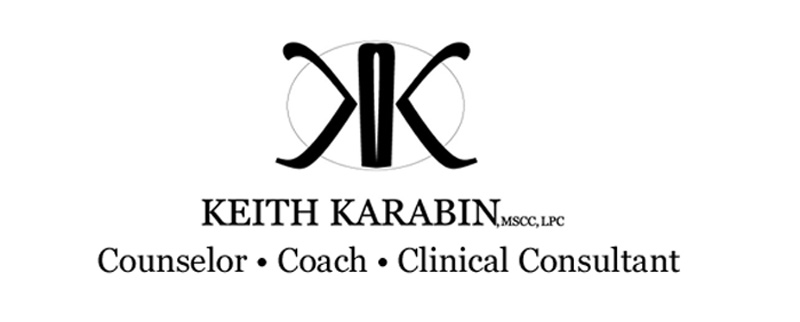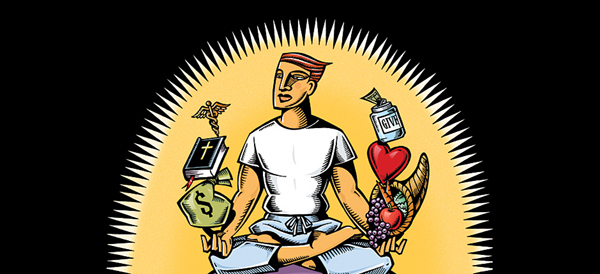Change is Overrated
“Life is what we make it, always has been, always will be.”
– Grandma Moses, Folk Artist
It’s time for me to be honest; I hate change. I hate the word’s baggage, I hate the fake finality, and I hate the dismissiveness. “Change is hard, change is good, and change is unavoidable…” we have a ton of sayings around change and I hate their triteness.
Why? Because our cultural concept of change is flawed from both directions. The idea that we “have to change” implies that there’s something wrong with us instead of something wrong with what we’re doing. It steals our power and dismisses the strong moments, character qualities and potential in our history by focusing on one or two problem behaviors. Looking to the future, the concept of change slashes a line in the sand and says, “from this day forth, I will never again be that old me!” Yes, from a spiritual perspective that happens, from a behavioral perspective there is no “new me” only the same strong me making healthier choices.
We know we strive for Living Wellness, here. Living Wellness is not about self-downing, it’s about self-building. To that end I offer the Wellness Plan developed by the now-illustrious Myers and Sweeny. If you are ready to build a healthier self, if you are willing to put aside self-downing…most of all, if you hate change but want to direct your Living Wellness, then let’s do it by the book.
Our Whole Self
“A man sooner or later discovers that he is the master-gardener of his soul, the director of his life.”
-James Allen, Philosopher
A Living Wellness involves every aspect of our selves, and Myers and Sweeny offer the Indivisible Self Model as the 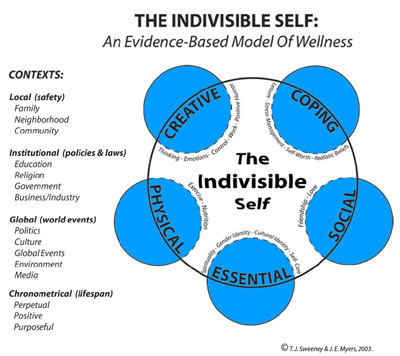 means to achieve this a goal, first targeted by Aristotle in ancient Greece, but still seeking “an inherent moderation and balance in life” in 2015. The model uses Adlerian Individual Psychology to illustrate “an organizing principle…in which body, mind, and spirit are integrated by the individual to live life more fully within the human and natural community” (Myers & Sweeney, 2008, p.5).
means to achieve this a goal, first targeted by Aristotle in ancient Greece, but still seeking “an inherent moderation and balance in life” in 2015. The model uses Adlerian Individual Psychology to illustrate “an organizing principle…in which body, mind, and spirit are integrated by the individual to live life more fully within the human and natural community” (Myers & Sweeney, 2008, p.5).
Within the model are “17 components that…interact with contextual and global forces to influence holistic well-being” (Myers & Sweeney, 2008, p.5). These 17 components have been divided into 5 key “selves” the Creative Self, Coping Self, Social Self, Essential Self and Spiritual Self. We can see them depicted in balance, within those contexts on the left; Local, Institutional (like government and neighborhood), Global and throughout the life span.
In terms of building an area of wellness, let’s look at what’s within each Self circle and keep an eye out for an area that we’d like to grow. If you want more in-depth definitions, just click the link here or in the end notes. It’s an awesome read (Myers, 2012).
Creative Self: Thinking. Emotions. Control Beliefs. Work. Positive Humor.
Coping Self: Leisure. Stress Management. Self- Worth. Realistic Beliefs.
Social Self: Friendship. Love.
Essential Self: Spirituality. Gender Identity. Cultural Identity. Self-Care.
Physical Self: Nutrition. Exercise.
Plan the Plan
“All the art of living lies in a fine mingling of letting go and holding on.”
– Henry Ellis, Explorer
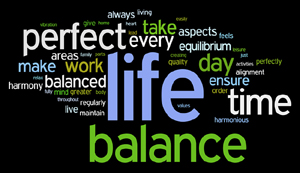 Got that area of growth identified? Great! Welcome to Step One: Assess Wellness and Select Area of Needed Growth. An open, honest acceptance of an area of life in which we need to grow is never easy, especially in our culture of “I’m okay, you’re okay” and overcompensation.
Got that area of growth identified? Great! Welcome to Step One: Assess Wellness and Select Area of Needed Growth. An open, honest acceptance of an area of life in which we need to grow is never easy, especially in our culture of “I’m okay, you’re okay” and overcompensation.
Step Two: Assess Stage of Change involves using James Prochaska and Carlo DiClemente’s Stages of Change model that we looked at in New Year’s Revolution. In short, it helps clarify how ready we are to actually make the changes needed to grow.
Step Three: Is to identify the thoughts, feelings and behaviors connected to our growth area, right now which fits into Step Four: Learn More about Ourselves. We’ve learned much already, but welcome to more. We can ask ourselves like “What stops my growth? What do I let stand in my way?” and the dreaded “What do I need to change or give up?”
That question is balanced by Step Five: Learn about the benefits of change and the strategies that other people have found successful.
The next step is making the plan itself.
And Now the Plan
“The more concrete and tangible your plan, the greater your potential for success. The less you make assumptions and the more you anticipate…the more easily you will realize your goals.”
-Jane Myers, Wellness Expert (2005, p. 180)
We come to Step Six: Develop, implement, evaluate and revise the plan. This one is harder to frame generically because it’s always going to be personal. I’ll share mine, addressing my need for growth in my Physical Self.
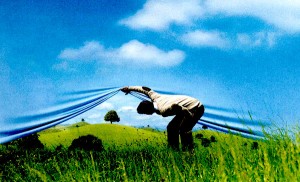 State Long range goal: Maintain a healthy weight for two years.
State Long range goal: Maintain a healthy weight for two years.
Break into weekly goals: Complete 3,000 calories of physical exercise and eat at least 50 fruit and vegetables.
Break into daily goals: (Time of day) Eat 500 calories (breakfast, lunch, dinner) and complete morning and evening workouts.
Outline the methods: the “who, what, when, where, and how of your behavior change process” (Myers and Sweeny, 2005, p. 181): I will learn healthy eating and exercise skills and practice them daily because maintaining a healthy weight means balancing the Nutrition and Exercise aspects of my Physical Self.
Tiny tasks and timelines: (include realistic stage of change progress): Right now I know that running a 10 kilometer race is beyond my physical ability and desire. But I will train weekly to complete a 5K race every season. I know that I will always crave salty, crunchy things, so I won’t give them up. But I will find healthy alternative foods like popcorn.
Explain the assessment methods: Weekly weight checks on the same scale, daily tracking and assessment of my calories taken in via food and put out via exercise.
List the positive and negative reinforcement: I focus even further on both internal and external reinforcement. I’m internally positively reinforced by feeling healthy and negatively reinforced by feeling stressed or out of control. I’m externally positively reinforced by my clothes fitting well and living a more fulfilling life, and by praise. I’m negatively reinforced by tempting social situations, stress eating and lack of time.
List supports and resources: My family, my nutritionist, my friends, my doctor.
These final two aspects of the plan actually highlights living, holistic wellness. Holistic wellness does not impact just in one circle of the self—like my Physical Self circle above—the nifty part about holism is that the balance of one helps balance all. So when we note how other areas will be effected we see that as I become more physically well I become better able to cope, have greater ability to be social, more mental energy to be creative and greater fulfillment in the essential things of life. But, if that’s not happening, or is resulting in negative impact to the other areas of my life then we evaluate and modify the plan, because a Living Wellness is alive and ever-evolving.
Change is not a moment, just like growth, they are constant states of movement. It is up to us to define if they are movement toward or away from the best self, and life, that we desire.
__________________________________________________
Karabin, K (2011) New Year’s Revolution. KeithKarabin.com. Retrieved From: https://keithkarabin.com//2011/12/30/new-years-revolution/
Myers, J. (2012) Wellness-Research.org. Retrieved from: http://wellness-research.org/wellness/docs/wellness.htm
Myers, J. E., & Sweeney, T. J. (2008). Wellness counseling: The evidence base for practice. Journal of Counseling and Development, 86(4), 482–493.
Myers, J. E., & Sweeney, T. J. (2005). Counseling for Wellness. American Psychological Association. Alexandria, VA.
